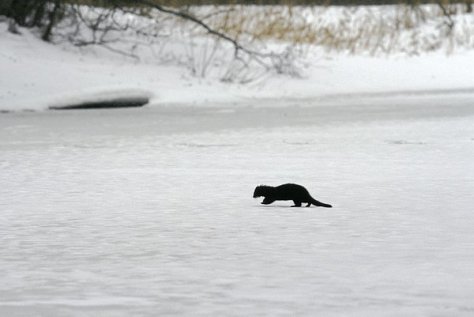Alien species with declining numbers
Photo: Arne Ader
Translation: Liis
Mink on Pedja River ice
Americam mink Mink or ameerika naarits Mustela vison
The peak period of these mustelids with the beautiful fur and the white throat patch seems to be at an end. Encounters in nature are fewer in recent years. The North American mink currently inhabits all of Europe but the little creature has not arrived here from America voluntarily. People brought them here for fur farms, but no prison is escape-proof.
Having escaped into nature the mink has annihilated the European mink in nearly the whole of Europe during the 20th century. It has turned out that some males can fertilize a European mink female, but unfortunately the foetus dies. The American minks are significantly more tolerant about food and habitat than the European minks and, being slightly bigger and stronger, they push out the food competitors from good habitats. In the shore areas of waters (both fresh waters and coastal waters) that the semi-aquatic creatures inhabit they destroy large numbers of nesting birds. Problems are inevitable with the mink, but fortunately its abundance is decreasing.
With a nocturnal and solitary way of life, minks are rather seldom encountered. A mink marks its territory with horribly smelling excrements that in addition are “scented“ with secretion from the anal glands. In fresh winter air even a human feels it but it needs not be blamed on somebody.
The mating period, starting in March, sets them looking for partners, thus we can see the creatures with beautiful fur coats in daytime, and roaming on „foreign territories“. Since the population is no longer very dense one animal can claim up to ten kilometres of river or creek bank as its own territory. Adult males are quite a bit larger than corresponding females, weighing some three-quarters more or up to 2,3 kilos, body length a maximum of 45 centimetres plus in addition some twenty centimetres of tail. The young born last year, with smaller body measures, are already sexually mature. The mating period is in fact the only meeting time of the animals, the kits born eleven weeks later will be fed and brought up by the “single mum“.
The winter diet consists of fish, frogs wintering in the bottom mud of waters, various shellfish, and on the banks mice are also hunted. The frosts of the last weeks have covered rivers with a strong lid of ice, and the minks try to move towards open water areas at rapids. If prints similar to those of a polecat (Mustela putorius) have moved along a river bank they can reasonably confidently be assumed to be mink tracks. The forepaw print is three centimetres long + long claws, and four centimetres wide. There is webbing between the toes of the rear paws, and the print is longer, up to five centimetres, but narrower, slightly more than three centimetres. Sometimes a straight line from a dragging tail can be noticed on the snow. The print track can disappear all at once from the river bank, then you can check where the creature has entered the water.









